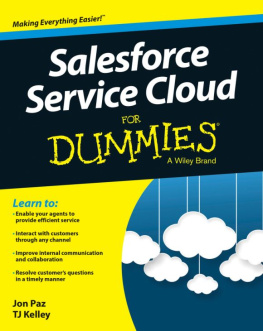Copyright 2012 Frances Frei and Anne Morriss
All rights reserved
Printed in the United States of America
10 9 8 7 6 5 4 3 2 1
No part of this publication may be reproduced, stored in or introduced into a retrieval system, or transmitted, in any form, or by any means (electronic, mechanical, photocopying, recording, or otherwise), without the prior permission of the publisher. Requests for permission should be directed to , or mailed to Permissions, Harvard Business School Publishing, 60 Harvard Way, Boston, Massachusetts 02163.
Library of Congress Cataloging-in-Publication Data
Frei, Frances.
Uncommon service : how to win by putting customers at the core of your business / Frances Frei, Anne Morriss.
p. cm.
ISBN 978-1-422-13331-6 (alk. paper)
Customer relations. 2. Customer services. 3. Service industriesManagement. I. Morriss, Anne. II. Title.
HF5415.5.F728 2012
658.8'12dc23
2011029760
The paper used in this publication meets the requirements of the American National Standard for Permanence of Paper for Publications and Documents in Libraries and Archives Z39.48-992.
How to Win by Putting Customers at the Core of Your Business

FRANCES FREI | ANNE MORRISS
HARVARD BUSINESS REVIEW PRESS
Boston, Massachusetts
Advance Praise for Uncommon Service
If you believe in service excellence, you must read this book. In it you will discover the importance of making the right choices and trade-offs in your business model so that your team can consistently deliver uncommon service.
Carlos Rodrguez-Pastor, Chairman, Interbank Group
Frances Frei and Anne Morrisss Uncommon Service is a joy to read and a treasure to study. The authors provide both theories of how great service works and case studies that demonstrate how to make it happen. Always intuitive, never patronizing, and really smart, Uncommon Service will help any executivein a big company or small, public firm or nonprofit organizationthink creatively about how to deliver service that truly works.
Debora Spar, President, Barnard College
Uncommon Service is about how to deliver service excellence by design. It shows managers how to satisfy customersnot just on your organizations best days, but as an everyday routine.
Tom Watson, Dean, Omnicom University; Cofounder and Vice Chairman Emeritus, Omnicom Group, Inc.

To our mothers and our sons,
who inspire us to serve
Contents
Acknowledgments
One of the gifts of working in academia is that you are surrounded by people who devote themselves to the art of education. They have no choice but to teach, and you have no choice but to learn, more often than not from every conversation. Throughout the book we have tried to celebrate the thinkers who have influenced us along the way, many of them colleagues who drive into the same parking lot every day. No doubt, we have fallen short.
We owe a particular debt of gratitude to the breakthrough work on services done by Ben Schneider and David Bowen, authors of Winning on Service, and Earl Sasser, Jim Heskett, and Len Schlesinger, authors of The Service Profit Chain. By capturing the importance of organizational design and the vital role that service employees play in building healthy companies, these books changed the way the world thought about the business of service. We have also been deeply influenced by the moral and intellectual courage of Clay Christensen, author of The Innovators Dilemma. Clay has an extraordinary ability to distill out the essential truths of a complex world.
Our hope in writing this book is to give people the toolsand audacityto go out and change organizations. Youngme Moon, author of Different, embodies this type of leadership. She has given us, and so many others, permission to dream.
Like Youngme, most of the messengers in this book study business. We dont typically associate service with the crass act of making money, yet for millions of people every day, the bulk of their human interactions takes place in a commercial setting. Do we really lose our humanity once we climb into the capitalist arena and add profit to the spoils? Of course not. Which means that we should be able to resolve the gap between the very human desire to serve and the frustrating service experiences were now asking each other to endure. It is a gap, we believe, the world is ready to close.
Introduction
If This Is a Service Economy, Why Am I Still on Hold?
We live and work in a service economy. In 1950, industrial workers represented the single largest employment sector in any developed country. Today, 80 percent of jobs are in service, and service represents 80 percent of the U.S. gross national product.
We cherish good service. In survey after survey, its an enormous differentiator in our experience as consumers. Companies that deliver service excellence get a disproportionate share of our income, and our loyalty to them is often difficult to shake. In researching this book, we encountered more than a few people who were brought to tears as they recalled an empathetic insurance provider or an airline experience that made them feel human, despite their screaming infant or lost luggage.
We find deep meaning in the act of serving. Weve been devising ways to take care of each otherand celebrating the resultssince the human story was first documented. Developmental psychologists tell us that a willingness to help strangers is a trait that most people exhibit at as young an age as eighteen months. Its an almost universal impulse to serve, one that can get crowded out by other instincts, certainly, but if you peel back the layers of what motivates us, more often than not youll find a very core ambition to be useful to others.
And yet. Good service is still, for the most part, rare. In our experience as economic actors, in industry across industry, were increasingly frustrated and disappointed. Customers, employees, ownersno one wants to deliver bad service, and no one wants to endure it. But thats the experience we continue to inflict on each other.
Why is that?
This is the question that animates this bookwhy is service so hard to get right, despite the fact that were wired for it? How can we channel the human impulse to serve into greater productivity, greater returns, and greater satisfaction all around?
Heres what weve learned: uncommon service is not born from attitude and effort, but from design choices made in the very blueprints of a business model. Its easy to throw service into a mission statement and periodically do whatever it takes to make a customer happy. Whats hard is designing a service model that allows average employeesnot just the exceptional onesto produce service excellence as an everyday routine. Outstanding service organizations create offerings, funding strategies, systems, and cultures that set their people up to excel casually.
In this book, we try to show you how to do the same thing: how to deliver uncommon service by design. Building any dynamic system means considering inputs and outputs, actions and reactions, and many of the concepts here are rooted in basic engineering principles. But psychology is where we find some of the largest obstacles to excellence. These take the form of denying reality and resisting trade-offs, points that may seem counterintuitiveor at least counter -comfortable.
If you walked out on the street today and randomly asked someone to talk about a recent service experience, good or bad, chances are the person would recount a story of deep disappointment. We know this because weve personally developed a bad habit of invading strangers personal space with questions like these. That story would probably involve a call center because, as well explain, call centers are designed to be reliably bad. But the story might just as easily be about wandering through department store aisles looking for a clerk to ring up an $8 pair of socks; or waiting for a shipment of parts that came in hopelessly late and hopelessly incomplete; or going through endless cycles with a voice-recognition unit (For what you dont want, push or say four), trying every numerical option in the hope of getting through to some sympathetic soul who has an incentive to care that your sons talking Elmo wont say a word.
Next page





